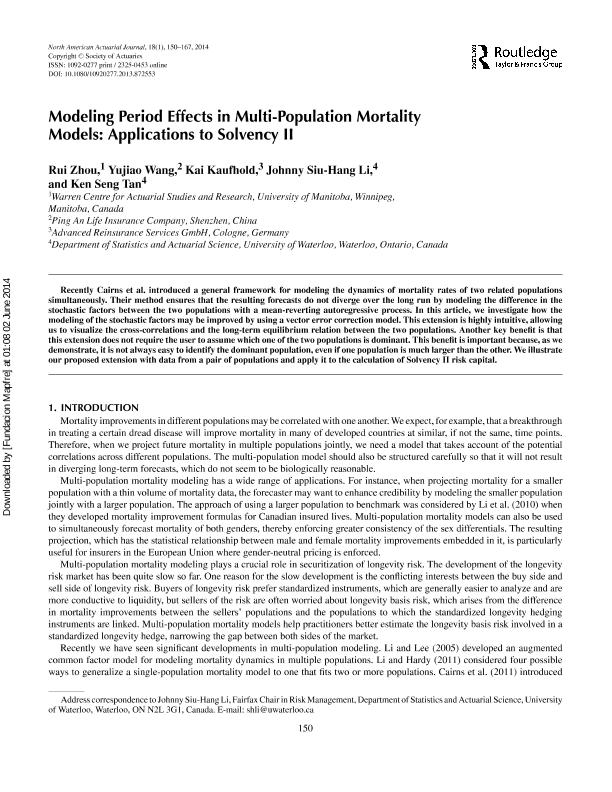Modeling period effects in multi-population mortality models : applications to Solvency II

Contenido multimedia no disponible por derechos de autor o por acceso restringido. Contacte con la institución para más información.
| Tag | 1 | 2 | Valor |
|---|---|---|---|
| LDR | 00000cab a2200000 4500 | ||
| 001 | MAP20140017225 | ||
| 003 | MAP | ||
| 005 | 20140603162416.0 | ||
| 008 | 140519e20140203esp|||p |0|||b|spa d | ||
| 040 | $aMAP$bspa$dMAP | ||
| 084 | $a6 | ||
| 245 | 0 | 0 | $aModeling period effects in multi-population mortality models$b: applications to Solvency II$cRui Zhou...[et.al] |
| 520 | $aRecently Cairns et al. introduced a general framework for modeling the dynamics of mortality rates of two related populations simultaneously. Their method ensures that the resulting forecasts do not diverge over the long run by modeling the difference in the stochastic factors between the two populations with a mean-reverting autoregressive process. In this article, we investigate how the modeling of the stochastic factors may be improved by using a vector error correction model. This extension is highly intuitive, allowing us to visualize the cross-correlations and the long-term equilibrium relation between the two populations. Another key benefit is that this extension does not require the user to assume which one of the two populations is dominant. This benefit is important because, as we demonstrate, it is not always easy to identify the dominant population, even if one population is much larger than the other. We illustrate our proposed extension with data from a pair of populations and apply it to the calculation of Solvency II risk capital. | ||
| 650 | 4 | $0MAPA20080592059$aModelos predictivos | |
| 650 | 4 | $0MAPA20080555306$aMortalidad | |
| 650 | 4 | $0MAPA20080564254$aSolvencia II | |
| 650 | 4 | $0MAPA20080586447$aModelo estocástico | |
| 650 | 4 | $0MAPA20080602437$aMatemática del seguro | |
| 700 | $0MAPA20110028855$aZhou, Rui | ||
| 773 | 0 | $wMAP20077000239$tNorth American actuarial journal$dSchaumburg : Society of Actuaries, 1997-$x1092-0277$g03/02/2014 Tomo 18 Número 1 - 2014 , p. 150-167 |

